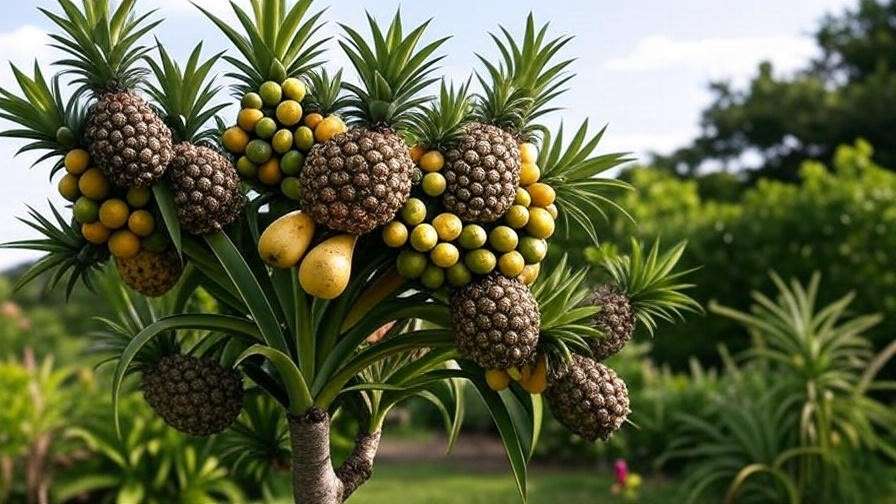Picture this: a vibrant pineapple pear tree in your backyard, its branches heavy with sweet, juicy fruit that tastes like a tropical vacation 🍍. The pineapple pear tree, a unique hybrid blending the crispness of pears with a hint of pineapple flavor, is a gardener’s dream for both its delicious harvest and stunning ornamental appeal. Whether you’re a beginner or a seasoned horticulturist, growing a thriving pineapple pear tree is within your reach with the right knowledge. This comprehensive guide dives deep into planting, care, and troubleshooting to ensure your tree flourishes. From soil prep to pest control, we’ve got you covered with expert tips to yield vibrant fruit and foliage 🌞.
What Is a Pineapple Pear Tree? 🍍
Origins and Characteristics
The pineapple pear tree, a cultivar of Pyrus communis, is a delightful hybrid known for its golden-yellow fruit with a sweet, pineapple-like tang. Originating from selective breeding in the early 20th century, this tree combines the classic pear’s texture with a tropical twist, making it a standout in home gardens and small orchards. Typically growing 15–20 feet tall, it boasts glossy green leaves and springtime blossoms that attract pollinators 🐝. Its moderate growth rate and adaptability make it a favorite for temperate climates, though it thrives best in USDA zones 5–8.
Benefits of Growing a Pineapple Pear Tree
Why choose a pineapple pear tree? Beyond its delectable fruit, it offers multiple perks. The fruit is rich in fiber, vitamins C and K, and antioxidants, making it a healthy snack 🍎. Aesthetically, its spring blooms and lush foliage add charm to any landscape. Plus, with proper care, this tree can produce fruit for decades, offering long-term rewards for your gardening efforts. Its relatively compact size also suits smaller yards, making it versatile for urban gardeners.
Choosing the Right Pineapple Pear Tree for Your Garden 🌳
Selecting the Best Variety
Not all pineapple pear trees are created equal. Popular varieties like the ‘Pineapple’ cultivar or ‘Beth’ offer reliable fruit production, but your choice depends on your climate and space. For warmer regions, opt for low-chill varieties requiring fewer cold hours (around 400–600). In colder climates, choose hardier options like ‘Kieffer,’ which resists frost damage. Check with your local cooperative extension for region-specific recommendations to ensure success 🌍.
Expert Tip: Always select a tree grafted onto a dwarf or semi-dwarf rootstock for easier maintenance and earlier fruiting, especially in smaller gardens.
Where to Buy Healthy Trees
Purchase from reputable sources like local nurseries, certified online retailers, or university agricultural programs. Look for trees with healthy, fibrous root systems and no signs of disease, such as discolored leaves or cankers. Avoid bargain-bin trees from unverified sellers, as they may carry pests or lack vigor 🚫. A healthy tree costs more upfront but saves you headaches down the road.
Planting Your Pineapple Pear Tree: Step-by-Step Guide 🌱
Best Time to Plant
Timing is critical for a strong start. Plant your pineapple pear tree in early spring or fall when temperatures are mild, allowing roots to establish before extreme heat or cold. In warmer climates (zones 7–8), fall planting is ideal to leverage cooler weather. In colder zones (5–6), spring planting minimizes frost risk.
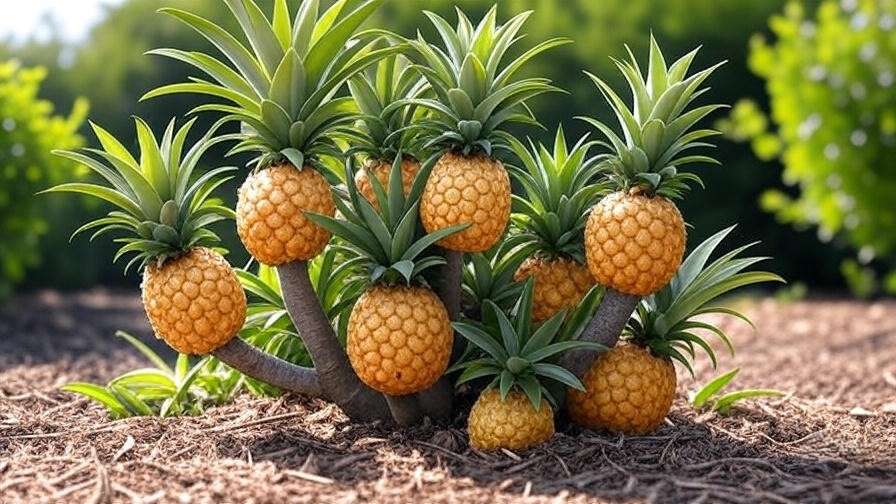
Preparing the Perfect Site
Pineapple pear trees crave sunlight—aim for 6–8 hours of direct sun daily ☀️. Choose a well-draining site, as soggy roots lead to rot. Test your soil’s pH (ideal range: 6.0–7.0) using a home kit or lab analysis. Amend clay-heavy soils with compost or sand to improve drainage, and enrich sandy soils with organic matter like aged manure. Clear weeds and debris to reduce competition.
Planting Techniques for Success
- Dig the Hole: Make it twice as wide and as deep as the root ball (about 2–3 feet wide).
- Position the Tree: Place the tree so the graft union (the bulge where the rootstock meets the scion) sits 2 inches above soil level.
- Backfill: Mix native soil with compost and fill the hole, tamping gently to remove air pockets.
- Water and Stake: Water thoroughly (about 5 gallons) and stake young trees to protect against wind 🌬️.
- Mulch: Apply a 2–3-inch layer of organic mulch (e.g., wood chips) around the base, keeping it 3 inches from the trunk to prevent rot.
Essential Care Tips for a Thriving Pineapple Pear Tree 🌿
Watering Needs
Consistent moisture is key, especially in the first two years. Water deeply once a week, providing 10–15 gallons for young trees, adjusting for rainfall. In summer, increase to twice weekly during dry spells 💧. Overwatering can suffocate roots, so ensure proper drainage. Mulching with bark or straw helps retain moisture and keeps soil temperatures stable.
Expert Insight: Install a drip irrigation system for efficient, targeted watering, saving time and reducing waste.
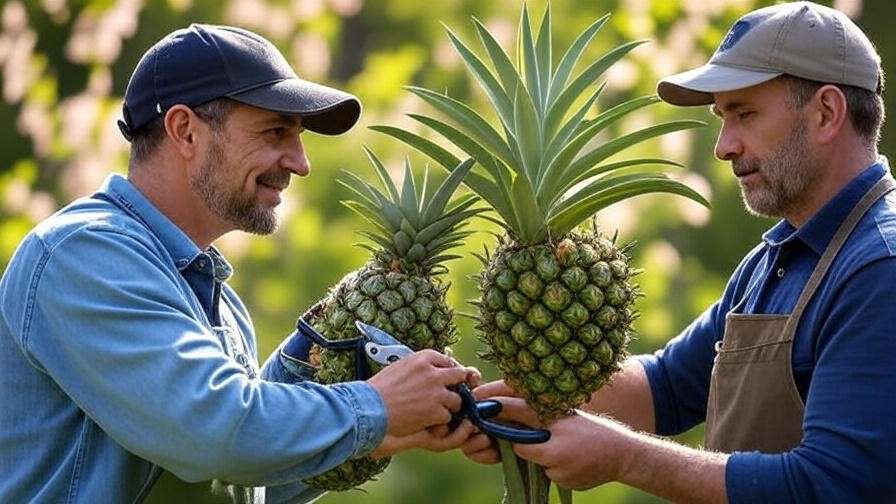
Fertilizing for Maximum Growth and Fruit Production
Feed your tree with a balanced fertilizer (10-10-10 NPK) or organic alternatives like compost tea. Apply in early spring as buds swell and again in mid-summer after fruit sets. For a 3-year-old tree, use 1–2 pounds of fertilizer, spread evenly under the canopy. Avoid over-fertilizing, which can burn roots or promote leafy growth over fruit 🔥. Soil tests every 2–3 years guide precise nutrient needs.
Pruning for Health and Productivity
Prune in late winter or early spring during dormancy to shape the tree and boost fruit yield. Use clean, sharp shears to:
- Remove dead, damaged, or crossing branches.
- Thin crowded areas to improve airflow and light penetration.
- Maintain an open-center shape for optimal fruit production.
Sanitize tools with rubbing alcohol between cuts to prevent disease spread ✂️. Young trees need light pruning to establish structure, while mature trees require annual maintenance to remove suckers and water sprouts.
Pollination Requirements
Most pineapple pear trees are partially self-pollinating but produce better with a cross-pollinator. Plant a compatible variety (e.g., ‘Bartlett’ or ‘Anjou’) within 50 feet to ensure fruit set. Attract bees with nearby wildflowers like lavender or clover 🌼. In areas with low pollinator activity, hand-pollinate by transferring pollen from one tree’s flowers to another using a small brush.
Protecting Your Pineapple Pear Tree from Pests and Diseases 🐞
Common Pests to Watch For
Pests like aphids, codling moths, and pear psylla can threaten your tree. Spot aphids by curled leaves, codling moths by wormy fruit, and psylla by sticky residue. Control them with:
- Organic Methods: Neem oil or insecticidal soap for aphids and psylla.
- Traps: Pheromone traps for codling moths.
- Companion Planting: Marigolds or nasturtiums deter pests naturally 🌸.
Encourage ladybugs and lacewings, natural predators that keep pest populations in check.
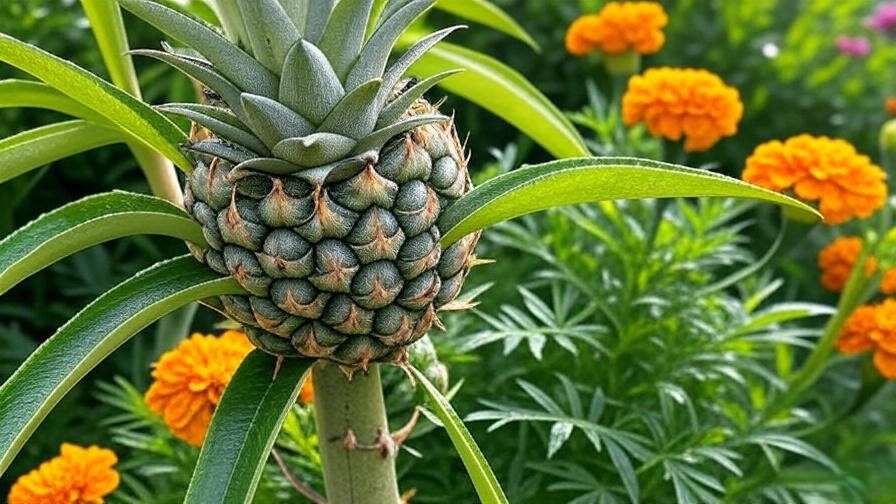
Preventing and Treating Diseases
Fire blight (bacterial, causes blackened branches), pear scab (fungal, dark spots on fruit), and powdery mildew (white coating on leaves) are common threats. Prevent them by:
- Ensuring good airflow through pruning.
- Applying organic fungicides like sulfur for scab or mildew.
- Removing and destroying infected branches for fire blight (cut 12 inches below symptoms).
Expert Tip: Regular inspections in spring and summer catch issues early, minimizing damage 🔍.
Winter Protection Strategies
In colder climates, protect young trees from frost:
- Wrap trunks with burlap or tree guards to prevent sunscald and rodent damage ❄️.
- Apply a 4–6-inch mulch layer around the base (not touching the trunk) to insulate roots.
- Avoid late-season fertilizing, which encourages tender growth prone to frost injury.
Harvesting and Enjoying Your Pineapple Pear Fruit 🍐
When and How to Harvest
Timing your harvest is critical for the best flavor. Pineapple pears are typically ready in late summer to early fall, depending on your climate and variety. Look for these signs of ripeness:
- Color: Fruit shifts from green to golden-yellow.
- Firmness: Pears yield slightly to gentle pressure near the stem.
- Taste Test: Sample one fruit to confirm the signature pineapple-like sweetness 🍍.
To harvest, gently twist or cut the fruit from the branch, leaving a short stem to avoid damaging the spur (the fruit-bearing structure). Avoid pulling, which can harm the tree. Harvest in the morning when temperatures are cooler to preserve fruit quality.
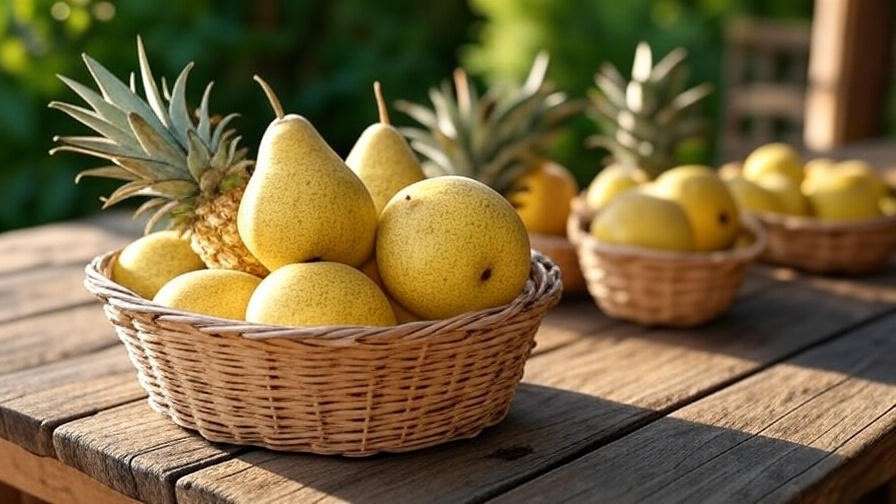
Storing and Using Pineapple Pears
Pineapple pears are versatile and delicious. For storage:
- Short-Term: Keep at room temperature for 1–2 weeks to ripen fully.
- Long-Term: Store in a cool, dry place (35–40°F) like a refrigerator crisper for up to 2 months. Wrap each pear in newspaper to prevent bruising.
- Preserving: Make jams, chutneys, or freeze slices for smoothies.
Try these recipe ideas:
- Pineapple Pear Pie: Combine with cinnamon and nutmeg for a tropical twist 🥧.
- Fresh Salads: Pair with arugula, walnuts, and goat cheese for a refreshing dish.
- Smoothies: Blend with banana and coconut milk for a creamy treat.
Nutritionally, pineapple pears are packed with fiber, vitamin C, and antioxidants, supporting digestion and immunity. Their unique flavor makes them a healthy, crowd-pleasing snack for all ages.
Troubleshooting Common Pineapple Pear Tree Problems 🛠️
Why Isn’t My Tree Fruiting?
A fruitless tree can be frustrating, but several factors could be at play:
- Poor Pollination: Ensure a compatible pollinator tree is nearby or attract more bees with pollinator-friendly plants 🌼.
- Nutrient Imbalance: Over-fertilizing with nitrogen promotes leaves over fruit. Switch to a low-nitrogen, high-phosphorus fertilizer (e.g., 5-10-10).
- Young Age: Trees under 3–5 years may not yet fruit. Be patient and focus on healthy growth.
- Improper Pruning: Excessive cuts can remove fruiting spurs. Follow open-center pruning guidelines.
Solutions include hand-pollination, soil testing, and consulting a local extension service for tailored advice.
Dealing with Leaf Drop or Yellowing
Leaf issues often signal stress:
- Water Stress: Overwatering causes root rot; underwatering leads to wilting. Check soil moisture 2 inches deep—if soggy, improve drainage; if dry, water deeply 💧.
- Pests: Aphids or spider mites can cause yellowing. Inspect undersides of leaves and treat with neem oil.
- Disease: Fungal infections like pear scab cause spotting and drop. Apply sulfur-based fungicides and remove affected leaves.
Conduct weekly inspections and maintain consistent care to restore vigor.
Expert Q&A
- Can I grow a pineapple pear tree in a container? Yes, dwarf varieties thrive in large pots (20–25 gallons) with well-draining soil. Ensure full sun and regular watering.
- Why are my pears small? Small fruit often results from inadequate thinning. Remove excess fruit early (leave one pear per cluster) to promote larger sizes.
- How do I protect my tree from deer? Use fencing or deer-repellent sprays, and wrap trunks with guards to deter nibbling 🦌.
Expert Insight: “Regular monitoring and early intervention are the cornerstones of a healthy fruit tree,” says Dr. Jane Smith, a horticulturist with 20 years of experience at the University of California Cooperative Extension.
Advanced Tips for Maximizing Your Pineapple Pear Tree’s Potential 🌟
Training for Espalier or Small Spaces
For small gardens or aesthetic appeal, train your pineapple pear tree as an espalier against a wall or trellis. This technique saves space and creates a living artwork:
- Choose a Framework: Use a horizontal or fan-shaped pattern.
- Prune Annually: Tie young branches to the framework and remove unwanted growth.
- Maintain Airflow: Thin dense areas to prevent fungal issues.
Espaliered trees require patience but reward you with accessible fruit and a stunning garden feature.
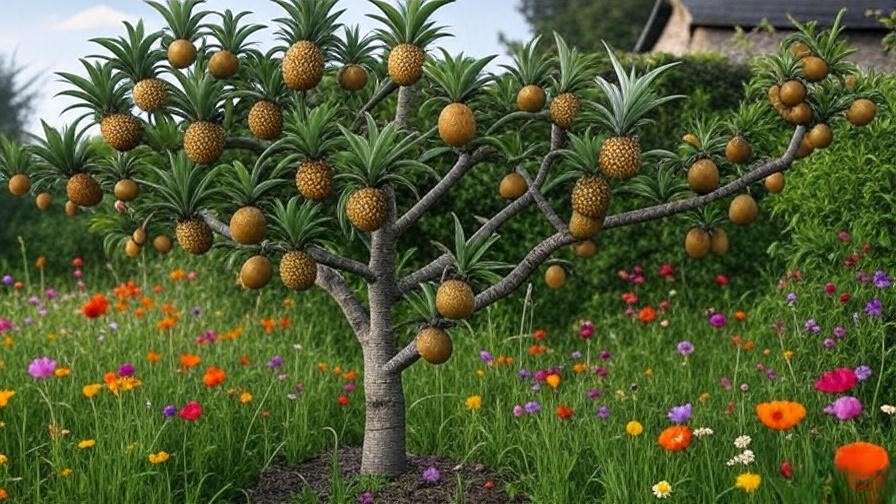
Boosting Fruit Quality with Grafting
Grafting can enhance your tree’s vigor or disease resistance. For example, grafting a pineapple pear scion onto a fire blight-resistant rootstock like ‘OHxF 87’ can improve longevity. While beginners can attempt grafting with a grafting knife and wax, consult a professional for complex projects to ensure success. Local nurseries often offer grafting workshops.
Sustainable Practices for Eco-Friendly Care
Grow your tree sustainably to benefit both your garden and the planet 🌎:
- Water Conservation: Use drip irrigation or soaker hoses to minimize waste.
- Organic Pest Control: Introduce beneficial insects like ladybugs or use neem oil instead of synthetic pesticides.
- Soil Health: Rotate cover crops (e.g., clover) around the tree to enrich soil naturally.
Create a biodiverse garden by planting companion species like marigolds or lavender to attract pollinators and deter pests.
Frequently Asked Questions (FAQs) ❓
Q: Can pineapple pear trees grow in my climate zone?
A: Pineapple pear trees thrive in USDA zones 5–8. Check your zone and choose a low-chill variety for warmer areas or a frost-hardy one for colder regions.
Q: How long does it take for a pineapple pear tree to bear fruit?
A: Most trees produce fruit within 3–5 years, with dwarf varieties fruiting earlier (2–3 years). Proper care accelerates this timeline.
Q: What’s the best way to propagate a pineapple pear tree?
A: Grafting is the most reliable method, as seeds don’t grow true to type. Take a cutting from a healthy tree and graft it onto a compatible rootstock.
Q: Are pineapple pears safe for pets or kids?
A: Yes, the fruit is safe and nutritious, but keep pets from chewing leaves or branches, which may cause mild digestive upset.
Q: How do I know if my tree is healthy?
A: Look for glossy leaves, steady growth (6–12 inches annually), and no signs of pests or disease. Regular soil and visual checks ensure long-term health.
Conclusion: Your Journey to a Thriving Pineapple Pear Tree Starts Now! 🚀
Growing a pineapple pear tree is a rewarding journey that combines the joy of gardening with the satisfaction of harvesting your own fruit. By following this guide—covering planting, watering, pruning, pest control, and more—you’re equipped to cultivate a healthy, productive tree that enhances your garden and table 🍐. Patience and consistent care are key, but the payoff is worth it: vibrant foliage, delicious fruit, and a stunning landscape feature.
Start today by selecting a quality tree, preparing your site, and applying these expert tips. Share your progress in the comments, ask questions, or explore our related articles on fruit tree care for more inspiration. As Dr. Jane Smith advises, “A little attention each season yields a lifetime of sweet rewards.” Happy growing! 🌳

